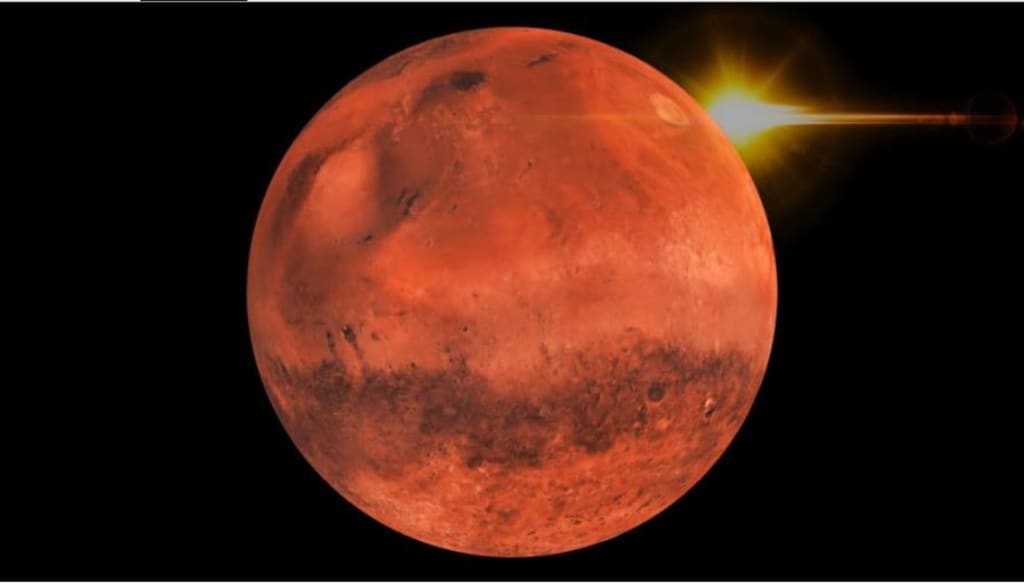
Mercury is the smallest planet in our solar system, and the second smallest is Mars.
Due to its surface covered with hematite, Mars has a unique orange-red appearance that looks mysterious in the night sky and was regarded as a brave god of war in ancient Roman mythology as early as BC.
In Chinese imagery, the color red represented blood and danger, so Mars was considered a "planet of calamity", but we now know that the red glow of Mars is the result of iron oxide gravel in the sunlight, and has nothing to do with calamity.
In the 1960s, the Soviet Union launched the first human Mars probe A1, and now there are more than forty probes that have reached Mars, which is considered by scientists to be the first choice for human migration because of its similar geological structure and almost the same motion cycle as the Earth, and some even believe that life once existed on Mars. That's why people are keen to explore Mars.
To study a planet, it is best to bring the planet's soil specimens back to Earth and analyze them in the laboratory with professional instruments, just like the moon soil brought back by the Apollo program and China's Change project, but so far mankind has never brought the soil of Mars back to Earth.
Because the Martian soil may be toxic
In the movie "Mars rescue", the protagonist was trapped on Mars, so he directly planted potatoes in situ, taking into account the future needs of immigrants, scientists also want to try the soil of Mars can not grow potatoes, so the soil samples of Mars has great significance for research.
But with so many benefits of bringing back samples, there is only one reason for the lack of action so far: the soil of Mars has a fairly high level of toxicity, and rushing back to Earth could have devastating consequences.
In the 1970s, NASA's Viking Mars rover landed on the surface of Mars, and in the images transmitted back, scientists determined that there may be a large amount of perchlorate in the form of chlorinated hydrocarbons on Mars, and in 2008 Phoenix landed on Mars, the airflow from the landing frame blew away some of the surface soil, and some long-standing water ice in the subsurface layer was exposed, and even formed some in the holder liquid droplets.
If the concentration of perchlorate reaches 30%-50%, the brine can remain liquid at -70°C, which indicates that the concentration of perchlorate is very high on the Martian surface.

Courage has found similar signs, and in earlier surveys, scientists had found liquid water flowing near canyons and craters in the summer months on Mars.
The flowing liquid water left black stains on the Martian surface that could reach hundreds of meters in length when temperatures got a little warmer. At the time, scientists weren't quite sure where the water came from and why it remained liquid in subzero conditions until researchers discovered the infrared signature of hydrated salts in the flowing black stains via the Mars Reconnaissance Orbit's spectral analyzer, and it dawned on them.
After further analysis, the concentration of perchlorate in Martian soil is around 0.5%, and not only that, many chlorine-based compounds on Mars can be very harmful to plants and animals on Earth.
Perchlorate cannot be metabolized by plants, so it slowly builds up in the plants and forms concentrated perchlorate on the growing branches and leaves. These perchlorates reduce the oxidation capacity of the plants and lead to a reduction in body size.
If humans inhale a large amount of perchlorate gas, or long-term high concentrations of perchlorate environment, will cause strong toxic effects on the lungs, and the thyroid gland also has great damage, seriously affecting physical development, resulting in brain underdevelopment, and ultimately mental retardation.
But if the future immigrants to Mars, perchlorate is not all useless
Scientists speculate that Mars was almost as rich in liquid water and a magnetic field that protected surface life as Earth was 3 billion years ago. Researchers have found clear traces of valleys on Mars, on which rocks were once subjected to heavy water flow, and nearby basin and delta deposits.
So it is likely that life existed on Mars billions of years ago, and although Mars is now barren, the possibility of underground lakes cannot be ruled out, and perchlorate, a water-soluble substance, can be used to find liquid water sources on Mars.
Although the Martian soil contains highly toxic, to better study the Martian environment, countries still have plans to take samples from Mars, in 2009, the European Space Agency and NASA respectively developed the "Mars 2020" rover and "Franklin" rover. The Franklin rover.
"The Franklin rover will sample Mars and land the sampler in the recovery landers of Curiosity and Mars 2020, which is risky, but future projects to The soil will have to be treated to make Mars a habitable planet.
About the Creator
Mejra
Later, respectively, wander and suffer sorrow.






Comments
There are no comments for this story
Be the first to respond and start the conversation.